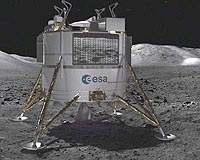 |
Tempe AZ (SPX) Jul 21, 2009 The imaging system on board NASA's Lunar Reconnaissance Orbiter (LRO) recently had its first of many opportunities to photograph the Apollo landing sites. The Lunar Reconnaissance Orbiter Camera (LROC) imaged five of the six Apollo sites with the narrow angle cameras (NACs) between July 11 and 15, within days of the 40th anniversary of the Apollo 11 mission. The early images obtained by LROC, operated by Arizona State University Professor Mark Robinson, show the lunar module descent stages left behind by the departing astronauts. Their locations are made evident by their long shadows, which result from a low sun angle at the time of collection. "In a three-day period we were able to image five of the six Apollo sites - the LROC team anxiously awaited each image," says LROC Principal Investigator Mark Robinson, professor in the School of Earth and Space Exploration in ASU's College of Liberal Arts and Sciences. "Of course we were very interested to get our first peek at the lunar module descent stages just for the thrill - and to see how well the cameras had come into focus." The orbiter's current elliptical orbit resulted in image resolutions from the NACs that were slightly different for each site but were all about four feet per pixel. Since the deck of the descent stage is about 14 feet in diameter, the Apollo relics themselves fill about four pixels. However, because the Sun was low to the horizon when the images were acquired, even subtle variations in topography create long shadows. Standing just over ten feet above the surface, each Apollo descent stage creates a distinct shadow that fills roughly 20 pixels. "For the five landing site images photographed by LROC, the biggest variables are spacecraft altitude (ground scale) and time of day, which translates into signal strength," explains Robinson. "In the current collection of images the best discrimination of features is in the Apollo 14 scene even though the highest resolution picture covers the Apollo 16 site." Compared to the other landing site images, the image of the Apollo 14 site revealed additional details. The Apollo Lunar Surface Experiment Package (ALSEP), a set of scientific instruments placed by the astronauts at the landing site, is discernable, as are the faint trails between the descent stage and ALSEP left by the astronauts' footprints. Though it had been expected that LRO would be able to resolve the remnants of the Apollo missions, these first images came prior to the spacecraft reaching its final mapping orbit. As the orbit of LRO is lowered, LROC will receive many more opportunities to image the landing sites in the weeks to come. The resolution of future LROC images of these sites will improve by two to three times. The timing of these images being captured is notable as it occurred only days before the 40-year anniversary of NASA's Apollo 11 mission that first put humans on the moon. Though these pictures provide a reminder of one of humankind's greatest technological achievements, LRO's primary focus is paving the way for future exploration. By returning detailed lunar data the LRO mission will help NASA identify safe and compelling landing sites for future explorers, locate potential resources, describe the moon's radiation environment and demonstrate new technologies. Share This Article With Planet Earth
Related Links Arizona State University LROC Mars News and Information at MarsDaily.com Lunar Dreams and more
 Europe cautious about moon return
Europe cautious about moon returnParis (AFP) July 20, 2009 The European Space Agency (ESA), on the 40th anniversary of the first lunar landing, said Monday any return to the moon had to be more than a flag-planting mission and multinational cooperation was key. ESA Director-General Jean-Jacques Dordain said that in 1969, Apollo 11's exploit was seen in terms of superpower rivalry, but today perceptions had changed. "I think the most important ... read more |
|
| The content herein, unless otherwise known to be public domain, are Copyright 1995-2009 - SpaceDaily. AFP and UPI Wire Stories are copyright Agence France-Presse and United Press International. ESA Portal Reports are copyright European Space Agency. All NASA sourced material is public domain. Additional copyrights may apply in whole or part to other bona fide parties. Advertising does not imply endorsement,agreement or approval of any opinions, statements or information provided by SpaceDaily on any Web page published or hosted by SpaceDaily. Privacy Statement |